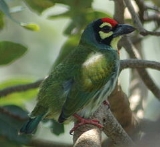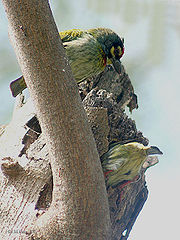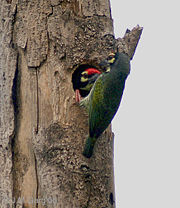
Coppersmith Barbet
Encyclopedia
The Coppersmith Barbet, Crimson-breasted Barbet or Coppersmith (Megalaima haemacephala), is a bird
with crimson
forehead and throat which is best known for its metronomic
call that has been likened to a coppersmith striking metal with a hammer. It is a resident found in South Asia
and parts of Southeast Asia
. Like other barbet
s, they chisel out a hole inside a tree to build their nest. They are mainly fruit eating but will take sometimes insects, especially winged termites.
-_juvenile_at_nest_in_kolkata_i_img_8293.jpg) This species of barbet is found to overlap in range with several larger barbets in most of South Asia. In the Western Ghats
This species of barbet is found to overlap in range with several larger barbets in most of South Asia. In the Western Ghats
, it partly overlaps with the Malabar Barbet
which is of a very similar size but having a more rapid call. The red forehead, yellow eye-ring and throat patch with streaked underside and green upperparts, it is fairly distinctive. Juveniles are duller and lack the red patches. The sexes are alike. The Sri Lankan form has more black on the face, more red on the breast and darker streaks on the underside.
During the nesting season, the wear and tear on the feathers can cause the plumage of the upper back to appear bluish.
Within the Old World Megalaima barbets, they are found to be basal in phylogenetic analyses. Most of the remaining Asian species are more recent in their divergence and speciation.
About nine subspecies are well recognized.
The remaining are island populations in Southeast Asia

 In the Palni Hills of southern India it is said to occur below 4000 feet. In the Himalayas it is found mainly in the valleys of the outer Himalayas up to 3000 feet. They are rare in the dry desert zones and the very wet forests.
In the Palni Hills of southern India it is said to occur below 4000 feet. In the Himalayas it is found mainly in the valleys of the outer Himalayas up to 3000 feet. They are rare in the dry desert zones and the very wet forests.
trees. Fond of sunning themselves in the morning on bare top branches of tall trees, often flitting about to sit next to each other. The flight is straight, with rapid flaps.
They compete with other cavity nesting birds and frugivores. Megalaima asiatica have been noted to evict them from their nest holes, while Red-vented Bulbul
s have been seen to indulge in kleptoparasitism
, robbing the male of berries brought to the female at the nest.
The nest holes are also used for roosting and some birds roost alone in cavities and these often roost during part of the day. Immatures will roost with the parents but often return to roost early so as not to be prevented by the parents from entering the roost cavity.
The beak remains shut during each call - a patch of bare skin on both sides of the throat inflates and collapses with each tuk like a rubber bulb and the head is bobbed.
_feeding_on_ficus_benghalensis_w_img_4356.jpg) Prefers Banyan
Prefers Banyan
, Peepul, and other wild figs, various drupe
s and berries, and the occasional insect, caught in aerial sallies. Petals of flowers may also be included in their diet. They eat nearly 1.5 to nearly 3 times their body weight in berries each day.
They breed through much of the year with local variation. The breeding season is mainly February to April in India and December to September in Sri Lanka. Both sexes excavate the nest on the underside of a narrow horizontal branch. They may also roost inside the nest holes. Three or four eggs are laid and like in many hole nesting birds the incubation period is not well known but has been estimated to be about 2 weeks. Both sexes incubate. Often two broods are raised in quick succession.
Bird
Birds are feathered, winged, bipedal, endothermic , egg-laying, vertebrate animals. Around 10,000 living species and 188 families makes them the most speciose class of tetrapod vertebrates. They inhabit ecosystems across the globe, from the Arctic to the Antarctic. Extant birds range in size from...
with crimson
Crimson
Crimson is a strong, bright, deep red color. It is originally the color of the dye produced from a scale insect, Kermes vermilio, but the name is now also used as a generic term for those slightly bluish-red colors that are between red and rose; besides crimson itself, these colors include...
forehead and throat which is best known for its metronomic
Metronome
A metronome is any device that produces regular, metrical ticks — settable in beats per minute. These ticks represent a fixed, regular aural pulse; some metronomes also include synchronized visual motion...
call that has been likened to a coppersmith striking metal with a hammer. It is a resident found in South Asia
South Asia
South Asia, also known as Southern Asia, is the southern region of the Asian continent, which comprises the sub-Himalayan countries and, for some authorities , also includes the adjoining countries to the west and the east...
and parts of Southeast Asia
Southeast Asia
Southeast Asia, South-East Asia, South East Asia or Southeastern Asia is a subregion of Asia, consisting of the countries that are geographically south of China, east of India, west of New Guinea and north of Australia. The region lies on the intersection of geological plates, with heavy seismic...
. Like other barbet
Barbet
American barbets, family Capitonidae, are near passerine birds of the order Piciformes which inhabit humid forests in Central and South America. They are closely related to the toucans....
s, they chisel out a hole inside a tree to build their nest. They are mainly fruit eating but will take sometimes insects, especially winged termites.
Description
-_juvenile_at_nest_in_kolkata_i_img_8293.jpg)
Western Ghats
The Western Ghats, Western Ghauts or the Sahyādri is a mountain range along the western side of India. It runs north to south along the western edge of the Deccan Plateau, and separates the plateau from a narrow coastal plain along the Arabian Sea. The Western Ghats block rainfall to the Deccan...
, it partly overlaps with the Malabar Barbet
Malabar Barbet
The Malabar Barbet is a small barbet found in the Western Ghats of India. It was formerly treated as a race of the Crimson-fronted Barbet. It overlaps in some places with the range of the Coppersmith Barbet .-Description:This species can be told apart from the Coppersmith Barbet by the crimson...
which is of a very similar size but having a more rapid call. The red forehead, yellow eye-ring and throat patch with streaked underside and green upperparts, it is fairly distinctive. Juveniles are duller and lack the red patches. The sexes are alike. The Sri Lankan form has more black on the face, more red on the breast and darker streaks on the underside.
During the nesting season, the wear and tear on the feathers can cause the plumage of the upper back to appear bluish.
Within the Old World Megalaima barbets, they are found to be basal in phylogenetic analyses. Most of the remaining Asian species are more recent in their divergence and speciation.
About nine subspecies are well recognized.
- nominate haemacephala (P. L. S. Müller, 1776) is found in the Islands of the Luzon and Mindoro in the Philippines
- indica (Latham, 1790) is found in the Indian Subcontinent form northeastern Pakistan and extends into Sri Lanka and Vietnam. Several former supspecies from India are synonymized into indica.
The remaining are island populations in Southeast Asia
- delica (Parrot, 1907) Sumatra
- rosea (Dumont, 1816) Java
- homochroa Dziadosz & Parkes, 1984 from Tablas
- celestinoi Gilliard, 1949 from CatanduanesCatanduanesCatanduanes is an island province of the Philippines located in the Bicol Region in Luzon. Its capital is Virac and the province lies to the east of Camarines Sur across Maqueda Channel. As of 2007, the population of the province is 232,757 people.-Etymology:"Isla de Cobos" was Catanduanes' first...
, BiliranBiliranIn 1945 liberated by the Philippine Commonwealth forces of the 9th Infantry Division of the Philippine Commonwealth Army was landed in Biliran with the local guerrilla forces by the attack of the Japanese troops from the island during the Battle of Biliran during World War II.-Conversion:On April...
, SamarSamarSamar, formerly and also known as Western Samar, is a province in the Philippines located in the Eastern Visayas region. Its capital is Catbalogan City and covers the western portion of Samar as well as several islands in the Samar Sea located to the west of the mainland...
, LeyteLeyteLeyte is a province of the Philippines located in the Eastern Visayas region. Its capital is Tacloban City and occupies the northern three-quarters of the Leyte Island. Leyte is located west of Samar Island, north of Southern Leyte and south of Biliran... - intermedia (Shelley, 1891) from PanayPanayPanay may refer to*Panay Island*Panay *Panay, Capiz*Panay River*Panay Gulf* USS Panay *Panay incident...
, GuimarasGuimarasGuimaras is an island province of the Philippines located in the Western Visayas region. Among the smallest provinces, its capital is Jordan. The island is located in the Panay Gulf, between the islands of Panay and Negros...
, Negros - cebuensis Dziadosz & Parkes, 1984 from CebuCebuCebu is a province in the Philippines, consisting of Cebu Island and 167 surrounding islands. It is located to the east of Negros, to the west of Leyte and Bohol islands...
- mindanensis Rand, 1948 from MindanaoMindanaoMindanao is the second largest and easternmost island in the Philippines. It is also the name of one of the three island groups in the country, which consists of the island of Mindanao and smaller surrounding islands. The other two are Luzon and the Visayas. The island of Mindanao is called The...
Habitat and distribution
Throughout their wide range they are found in gardens, groves and sparse woodland. Habitats with trees having dead wood suitable for excavation is said to be important. Birds nest and roost in cavities.

Behaviour and ecology
Keeps solitary, pairs, or small groups; larger parties occasionally on abundantly fruiting FicusFicus
Ficus is a genus of about 850 species of woody trees, shrubs, vines, epiphytes, and hemiepiphyte in the family Moraceae. Collectively known as fig trees or figs, they are native throughout the tropics with a few species extending into the semi-warm temperate zone. The Common Fig Ficus is a genus of...
trees. Fond of sunning themselves in the morning on bare top branches of tall trees, often flitting about to sit next to each other. The flight is straight, with rapid flaps.
They compete with other cavity nesting birds and frugivores. Megalaima asiatica have been noted to evict them from their nest holes, while Red-vented Bulbul
Red-vented Bulbul
The Red-vented Bulbul is a member of the bulbul family of passerine birds. It is resident breeder in tropical southern Asia from India and Sri Lanka east to Burma and southwestern China. It has been introduced and has established itself in the wild in many Pacific islands including Fiji, Samoa,...
s have been seen to indulge in kleptoparasitism
Kleptoparasitism
Kleptoparasitism or cleptoparasitism is a form of feeding in which one animal takes prey or other food from another that has caught, collected, or otherwise prepared the food, including stored food...
, robbing the male of berries brought to the female at the nest.
The nest holes are also used for roosting and some birds roost alone in cavities and these often roost during part of the day. Immatures will roost with the parents but often return to roost early so as not to be prevented by the parents from entering the roost cavity.
Vocalization
The call is a loud rather metallic tuk…tuk…tuk (or tunk), reminiscent of a copper sheet being beaten, giving the bird its name. Repeated monotonously for long periods, starting with a subdued tuk and building up to an even volume and tempo, the latter varying from 108 to 121 per minute and can continue with as many as 204 notes. They are silent and do not call in winter.The beak remains shut during each call - a patch of bare skin on both sides of the throat inflates and collapses with each tuk like a rubber bulb and the head is bobbed.
Diet
_feeding_on_ficus_benghalensis_w_img_4356.jpg)
Banyan
A banyan is a fig that starts its life as an epiphyte when its seeds germinate in the cracks and crevices on a host tree...
, Peepul, and other wild figs, various drupe
Drupe
In botany, a drupe is a fruit in which an outer fleshy part surrounds a shell of hardened endocarp with a seed inside. These fruits develop from a single carpel, and mostly from flowers with superior ovaries...
s and berries, and the occasional insect, caught in aerial sallies. Petals of flowers may also be included in their diet. They eat nearly 1.5 to nearly 3 times their body weight in berries each day.
Breeding
Courtship involves singing, puffing of the throat, bobbing of the head, flicking of the tail, ritual feeding and allopreening.They breed through much of the year with local variation. The breeding season is mainly February to April in India and December to September in Sri Lanka. Both sexes excavate the nest on the underside of a narrow horizontal branch. They may also roost inside the nest holes. Three or four eggs are laid and like in many hole nesting birds the incubation period is not well known but has been estimated to be about 2 weeks. Both sexes incubate. Often two broods are raised in quick succession.
Mortality factors
Adult birds are sometimes taken by predatory species. In urban areas, there are records of collisions with structures including white walls. Pesticide poisoning has also been noted.External links
- Coppersmith Barbet videos, photos & sounds on the Internet Bird Collection
- Skull

